News
STA, 21 November 2018 - Luka Mesec, the leader of the Left, pinpointed some of the issues for the party in the draft supplementary budget for 2019 on Wednesday by saying that the government faced the dilemma between "guns and butter".
Mesec said the Left, a partner to the Marjan Šarec minority government, was happy that the draft budget implementation bill envisaged an increase in the annual allowance for pensioners, an extra adjustment of pensions, and 10 new jobs at the Labour Inspectorate.
The draft, which the party received today, also contains a provision saying that public sector staff would as a rule have salaried jobs instead of being hired by agencies, which means they will also have appertaining worker rights.
However, Mesec said that there was a major flaw in the draft, which was that social transfers such as child benefit, baby bonus, unemployment benefit, disability benefits and scholarships would not be adjusted to inflation next year, measures valued at EUR 16m.
Mesec juxtaposed that to the EUR 15.5m deal to procure 38 Oshkosh armoured personnel vehicles for the Slovenian Armed Forces to form a battalion-sized battlegroup, the signing of which had been confirmed by Defence Minister Karl Erjavec.
The Left has been opposing the deal for months on the grounds that Slovenia is not facing any such threat to national security. Mesec said that even in case of aggression against Slovenia, the four-wheelers would not come useful because they were meant for offensive rather than defensive action, while they were also useless for civilian purposes.
The party thus called on the government to reconsider the contract. It will also call a session of the parliamentary Defence Committee to propose rescinding the deal and a legislative amendment under which any defence procurement in excess of EUR 1m would require parliament's consent.
The Slovenian military has had no casualties for more than two decades
In response the Defence Ministry said that the Oshkosh light combat all-terrain vehicles to be supplied to the army between 2021 and 2023, would replace the worn out Hummer vehicles and would provide troops with a high-level of protection, which was one of the main reasons for the purchase.
The ministry said that a well-protected armoured vehicle had proven to be essential for the survival of teams in combat and non-combat incidents as the one in Afghanistan a few years ago as Slovenian troops on a routine mission run onto an explosive device and "the vehicle's armour prevented fatalities and major injury".
The ministry said that Slovenia was one of few countries without casualties during more than two decades it had been participating in various international missions, and that high security and protection standards would remain a key requirement in army equipment in the future.
The ministry initiated procurement of 38 Oshkosh light combat vehicles in the previous term and completed it last week by signing an agreement with the US administration.
All our stories about the Slovenian military are here
STA, 21 November - Democrat (SDS) leader Janez Janša announced his party would seek an advisory referendum on the UN Global Compact for Migration as discussion in parliament reaffirmed the divide among parties on the matter. At the same time, around 200 protesters gathered outside the parliament in opposition to the deal.
Parliament discussed in an emergency session on Wednesday the UN global compact at the behest of the conservative opposition Democrats (SDS), New Slovenia (NSi) and National Party (SNS), which consider the compact dangerous for Slovenia and believe the government should reject it.
MP Branko Grims, the SDS's chief migrations bullhorn, reiterated their stance that the agreement, which is to be adopted in Marrakesh, Morocco, next month, was misleading and would not tackle the root causes of migrations.
Conservatives also took issue with the way the decision to back the deal was made in Slovenia, with Janša saying that parliament should have discussed it first and only then the government instead of vice-versa.
Related: Šarec - Slovenia supports UN Compact, but opposed to illegal migration
"You did not leave us any other choice but to file for an advisory referendum," he said and added that the name of the deal was misleading.
In a reference to the decision of the US not to take part in the compact, Janša said that no deal that was not supported by all members of the UN Security Council was global.
On the other hand, Foreign Minister Miro Cerar reiterated that it was key for Slovenia to remain in the group of more than 150 countries by joining the compact. "This way, we will manage together the thing that no country can manage alone - mass migrations and illegal migrations."
He told the press that the opposition was "scaring people by misleading them, telling numerous nontruths and intentional lies".
"There are a few hundred refugees in Slovenia. Our borders are controlled," he stressed.
But this view is not shared by around 200 protesters in front of the parliament building carrying banners such as Slovenia for Slovenians. Protesters, who were also invited to join by Janša, are urging the government to reject the UN compact.
The session has been suspended, but it will end without any decisions anyway, because the proposal of the conservative parties was voted down by parliamentary committees last week.
UPDATE: The STA also reports that the Democrats (SDS) filed a demand for an advisory referendum on the UN Global Compact for Migration on Wednesday following a parliamentary session on the document. For the vote to take place, the motion needs to be endorsed by a regular majority in parliament.
A statement from the SDS said after the session that the motion was filed together by the SDS and the National Party (SNS).
The debate at the plenary indicated today that the only other party opposing the the government's decision that Slovenia support the document in Marrakesh in early December is the conservative New Slovenia (NSi).
Together, the three parties have 36 seats in the 90-member legislature.
If endorsed, the referendum question will read: Are you in favour of Slovenia joining the Global Compact for Safe, Orderly and Regular Migration that equates legal and illegal migrations?
SDS head Janez Janša called on other parties to support the motion and give the people a chance to voice their position after reading the compact. The Slovenian translation of the document has been available as of yesterday.
Janša indicated that the SDS would file the referendum motion during the plenary, saying that the process in which the document was approved in Slovenia was anti-constitutional and illegal. The government decided to endorse the document without political or legal discussions.
All our stories on immigration and Slovenia are here
A statement from the SDS said after the session that the motion was filed together by the SDS and the National Party (SNS).
The debate at the plenary indicated today that the only other party opposing the the government's decision that Slovenia support the document in Marrakesh in early December is the conservative New Slovenia (NSi).
Together, the three parties have 36 seats in the 90-member legislature.
If endorsed, the referendum question will read: Are you in favour of Slovenia joining the Global Compact for Safe, Orderly and Regular Migration that equates legal and illegal migrations?
DELO
Healthcare
"Who will treat us if we fall ill?": Young doctors in Slovenia no longer want to specialise in general practice, with only 12 responding to the 119 open posts for specialisation in this branch of medicine. (front page, 2, 8)
Pensioners
"Pensioners can look forward to higher annual allowance": Pensioners can look forward to higher annual allowances in 2019 as the draft budget implementation bill envisages EUR 140m for this purpose (EUR 18m more than this year). The government will discuss the bill today. (front page, 3)
Infrastructure
"A ten-metre hole in middle of road": Renovation work on the railway tunnel near Šentilj caused a ten-metre sinkhole on the road next to the exit ramp from the A1 motorway near the border town. (front page)
DNEVNIK
Survey
"Big rise in support for Marjan Šarec government": The support for the government of Marjan Šarec has grown significantly in the latest Vox Populi poll; in fact it has doubled to 44.2%. Šarec himself also gained in popularity, rising from the fourth to the second place in the rankings. (front page, 2)
Slovenian Sovereign Holding
"Andrej Božič already has one foot in SSH management": Slovenian Sovereign Holding supervisory board is to appoint the two missing members of the state assets custodian today, with Andrej Božič, the former chairman of Steklarna Hrastnik, a large glassworks, enjoying the support of the ruling Marjan Šarec List (LMŠ) and several supervisors. (front page, 3)
Football
"Matjaž Kek returning to the coach's seat": Matjaž Kek, who coached the national football team in 2007-2011, will likely return to the hottest seat in Slovenian sport, the paper cites unofficial but reliable information. (front page, 17)
FINANCE
Construction
"Unpaid subcontractors: How did Cerknica-based builder stray on path of fallen construction barons?": AS-Primus, the Cerknica based construction company, has received municipality and EU funds for several projects, but it owes more than EUR 1m to subcontractors. (front page, 4, 5)
Economic cooldown
"Another downgraded forecast for Slovenia's growth: Who is already feeling the cooldown?": The OECD is the latest institution that has downgraded Slovenia's GDP growth forecast for the coming two years. Business results and projections of certain companies also indicate that a cooldown may be coming. (front page, 2, 3)
Takeovers
"Turks and postmen to apparently fight for Intereuropa": After the failed sale of logistics company Intereuropa two years ago, the biggest shareholders invited four interested buyers to submit binding bids last month. It appears that the postal operator Pošta Slovenije and Turkish Netlog Logistics are the most interested. (front page, 10, 11)
VEČER
Trade unions
"Initials and protests": As three public sector trade unions reached a EUR 306m deal with the government, the Pergam and ZSSS trade union confederations announced a protest rally in front of the Chamber of Commerce and Industry (GZS) for 5 December to demand higher wages for all. (front page, 2, 3)
Infrastructure
"Sinkhole on the road above tunnel": A huge sinkhole appeared at a crossroads in Šentilj, caused by works in the tunnel that runs six metres below the road. (front page, 10)
Companies
"Hotel of 100 irregularities": City Hotel is one of the nicest hotels in Maribor, but there are a number of irregularities, with Mestna Vrata, the hotel's owner controlled by a secretive Austrian company Ho-Com, avoiding the start of receivership and the police investigating the hotel's business. (front page, 6)
Exploring somewhere on vacation can often seem like a chore, as you move down a checklist of must-see sights and must-do activities, without really engaging with the streets and the public, lived environment. This is a particular shame in Slovenia, where the pleasures of its small towns and cities are perhaps best enjoyed by allowing yourself to get lost and wander as you move between the prescribed points of interest, safe in the knowledge that you’re never far from the centre. But how to structure such trips to allow for serendipity, discovery and success in terms of a new place known well? How to plan to be surprised without ruining the surprise?
One way is to let someone else take control of the situation, and a novel approach to this can be found in a new venture by three women working out of Murska Sobota, under the name Stride & Seek. We’ll get to the details later on, but for now just know that we were intrigued by the project and sent Hayley Handford-Brown, one of the founders, a few questions about her life and work in Slovenia that she kindly answered.
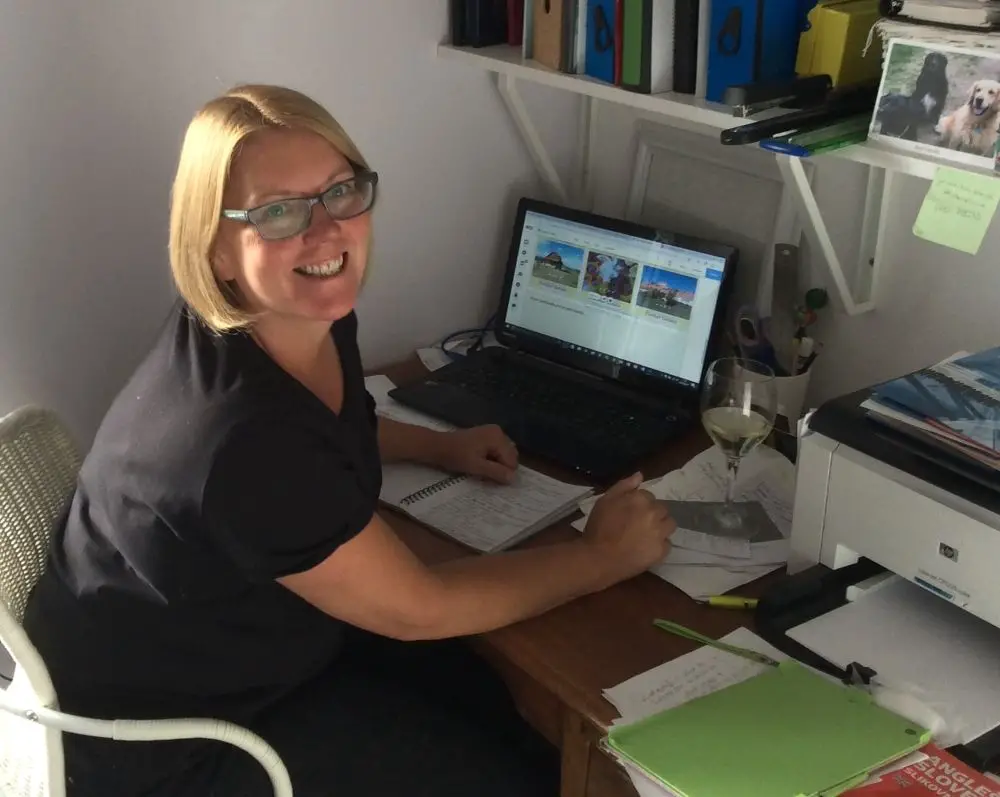
Hayley Handford-Brown
Where you before moving to Slovenia, and what brought you here?
I lived in Lincolnshire, which is fairly rural but quite flat, before coming to Slovenia. So, one of the things that really attracted us to Slovenia was the countryside, and the feeling of getting away from it all that we have here, whilst still having all the amenities you need on your doorstep. I love how safe I feel here and how friendly and neighbourly people are.
What were some of the challenges you faced on moving here, and how did you deal with them?
We actually bought our house here 10 years before we relocated so were well acquainted with the area. Also, in that time, my parents bought a house and retired here six years before we made the big leap. I suppose we had the luxury of time to become aware of any challenges that we may face and made plans for them.
The biggest challenge that we didn’t anticipate was how hard the language would be to grasp. During those 10 years, we visited twice a year, every year but during this period we were renovating either our property or my parents, so didn’t get out and about much and had the mentality that once we lived here, we would learn the language, be so immersed in it that it would come to us. Even though I’ve had lessons and learnt languages before (in fact, I quite like learning languages – it’s something I did at university!) it’s just such a difficult language. And what with one thing and another, haven’t been able to devote as much time as I would have liked to learn it. Oh, and sometimes when you do get the confidence to try and speak it, it’s all wrong and you’re not understood which can be very disheartening!
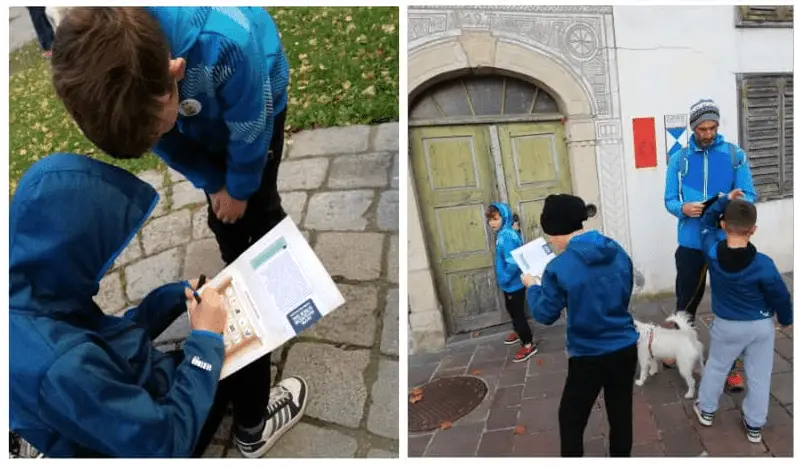
What were you doing here before Stride & Seek?
Stride & Seek Mini Adventures came about after a discussion I had about the concept with an expat business woman, I was picking her brain about something and she just enquired about our future plans. If she hadn’t had asked that question at that point then Mini Adventures wouldn’t be what it is now.
In the UK, we had been franchisees for the leading treasure hunt company, and having been in Slovenia for a while at that time knew that it would be a good concept here, but it wasn’t something I could do on my own – I really wanted Slovene business partners. So, she actually set me up with a Slovene lady she knew that would be perfectly suited, a bit like a blind date for a business partner, and it worked! Katja (the blind date) had a colleague who she brought on board so Tamara joined us and one became three.
The product we offer is pretty different to what I was doing in the UK, which has been great as we have really been able to be creative and imaginative with our Mini Adventures. And we all have different areas of expertise. Katja is responsible for marketing and sales, Tamara writes and translates the Mini Adventures, I write and do the operational side of things, as well as developing any new concepts. We are only at the start of our journey and have lots of exciting things in the pipeline.
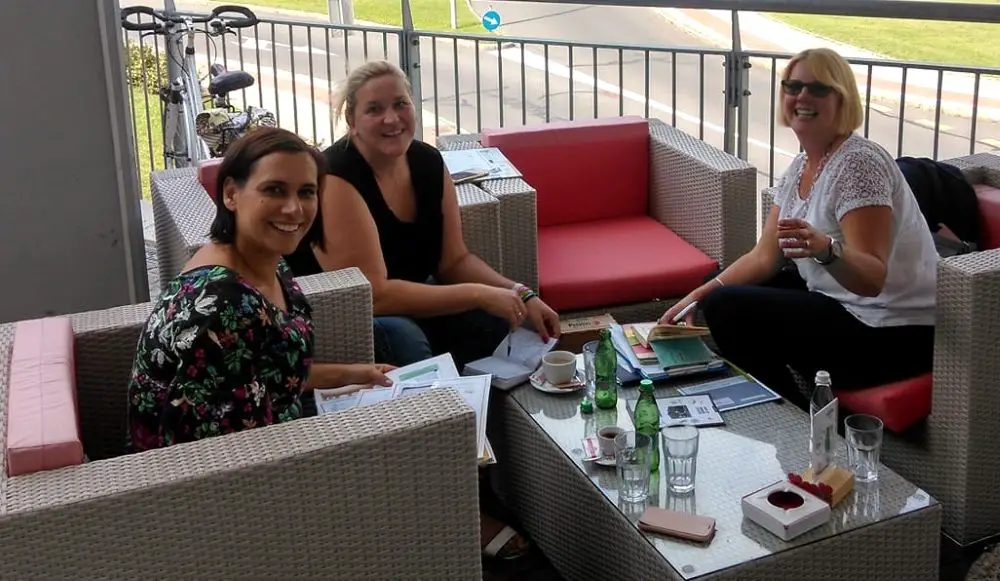
The team at Stride & Seek
For people who haven’t visited your website yet (in English and Slovene), can you talk me through the experience of doing a Mini Adventure?
A Mini Adventure features a hand drawn map of your chosen city or town leading you on a self-guided tour by visiting the markers on the map where a clue has to be found and solved. Discovering the place in a different and unique way. A story accompanies the adventure, usually loosely based on a legend or myth of that location which sets up the mission ahead.
It’s great fun for all ages. Kids love running around looking for the clues and adults get to exercise their brains as some of the clues are more challenging. And it’s good old-fashioned fun. We love the fact that our product brings people together, making memories and getting them away from screens and devices. It’s perfect if you have friends visiting and you want to show them the area or if you just want a day out getting reacquainted with a place.
It’s educational too as well as healthy (don’t let the kids know, though!) as we feature information about the landmarks our “Seekers” are seeing on their adventure. Our Mini Adventures thus make people more aware of what’s around them whilst exploring rather than just wandering around aimlessly on their own.
Some of the finer details of buildings, statues and monuments are often overlooked. One of our reviewers said of the Ljubljana Mini Adventure he did that although he grew up in Ljubljana, he discovered landmarks he’d never seen before. We include more than just the more popular sights, we love the unusual!
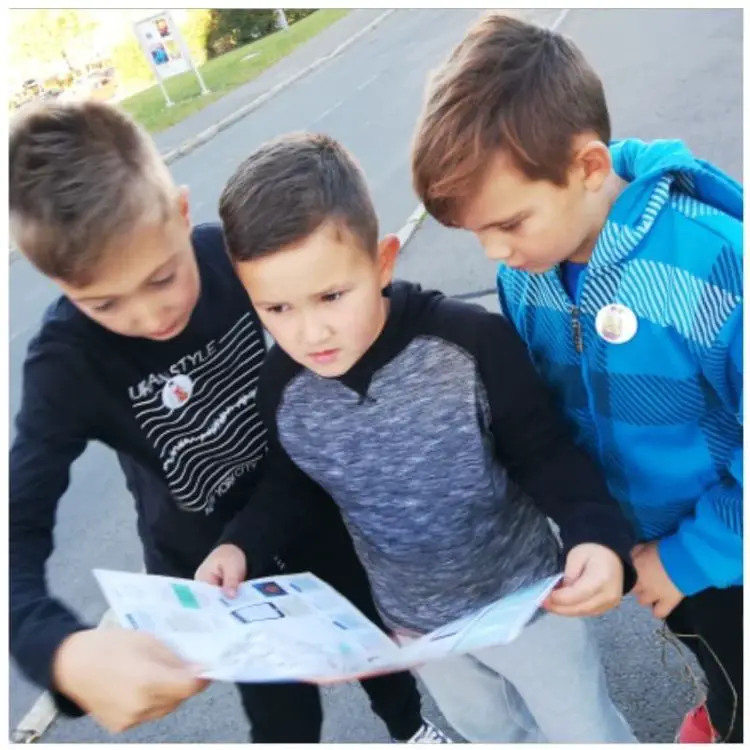
What are some things you’ve learned making these adventures?
I’ve learnt so much more about Slovenia from producing these Mini Adventures, not just from a tourist prospective either, because they are for locals and tourists alike. I have particularly enjoyed learning about the history and legends of our locations and get a real buzz out of writing the story that accompany the adventure. And we have quite a few locations already, even though we are just starting out. We currently offer Celje, Lake Bled, Ljubljana, Maribor, Murska Sobota, Ptuj, Piran and Bad Radkersburg. We have Škofja Loka, Graz, Budapest and Bratislava coming very soon. And in the next three months – Kranj, Velenje, Zagreb and Varaždin will be added to the catalogue. So, we are keeping very busy but we still have time for a chat if you see us out about, looking intently at statues with a notebook and camera in hand, be sure to say hello!
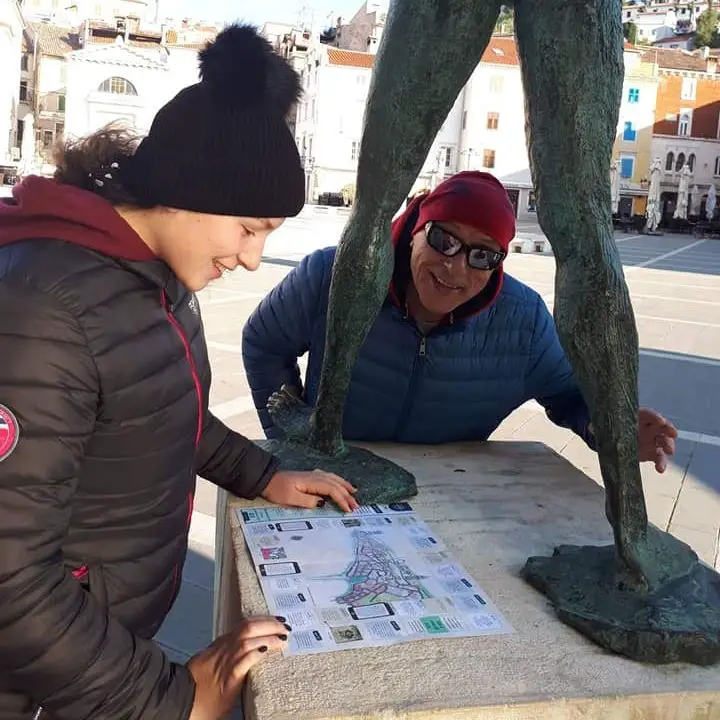
You can learn more about Stride & Seek Mini Adventures, and order a map of your own, at the project’s website, and you can also follow along on Facebook or Instagram. And if you'd like to share your story with our readers, then please get in touch at This email address is being protected from spambots. You need JavaScript enabled to view it.
STA, 21 November 2018 - A Slovenian project promoting intercultural connections, integration and education of women from the Western Balkans has won the international Alpine Pluralism Award 2018. The award was conferred in Innsbruck on Tuesday to the head of the humanitarian association UP Jesenice that runs the project, Faila Pašić Bišić.
The award-winning project is entitled Hands Revealed (Razkrite roke), which is a reference to the women who conceal their faces and communicate with the world through their loving and hard-working hands.
Currently, 30 women with a migrant background participate in the project, making unique textile products, which are available for sale.
The project is run by UP Jesenice for the fourth year in cooperation with the Ljubljana-based institute for modern textile art and design OLOOP.
This year, the project has been upgraded with a web site (here), where the hand-made products combining the traditional with modern as well as the women who create them are presented.
REVEALED HANDS from Žin on Vimeo.
"We are trying to complement social cohesion with art, not just folklore and cuisine," Pašić Bišić said about the project of including women from the Western Balkans in the labour market.
By taking part in the project, the women overcome many obstacles. "With Albanian women, we first had to talk to their husbands, because these cultures are extremely patriarchal and women are pushed in a passive role," Pašić Bišić said.
But while talking to the men, Pašić Bišić was shocked to learn that they too are socially very excluded despite having a job and speaking Slovenian, which are two crucial factors for integration.
"They do not know how the local community functions, they are not active in any sports associations and they do not know their environment," she said.
These are also the problems that their project is trying to overcome.
The Alpine Pluralism Award is conferred by non-profit organisation Cipra Lab and a task force operating as part of the EU strategy for the Alpine macroregion.
The Hands Revealed project is funded by the state and the EU social fund.
STA, 21 November 2018 - Gault & Millau has published a Slovenian edition of its high-profile restaurant guide. A total of 130 restaurants across the country are featured, with the highest scores awarded to restaurants by celebrity chefs already considered among the best places to eat in Slovenia.
Two two highest-rated restaurants are Pri Lojzetu, the restaurant at Zemono Mansion run by celebrity chef Tomaž Kavčič, and Hiša Franko in Kobarid, the home of Ana Roš, who was declared the world's best female chef in 2017 by the culinary portal World's 50 Best Restaurants.
They both received the highest mark awarded in Slovenia, 17.5 points, and four white hats. Gault & Millau rates restaurants on a scale of 1 to 20, with five the maximum number of hats.
Related: Slovenia becomes first country named a European region of gastronomy
Four more restaurants received four hats but half a point less.
Chef Gregor Vračko's Hiša Denk in Kungota in eastern Slovenia and his brother David's eatery Mak in Maribor made the cut, as well as chef Igor Jagodic's Strelec in Ljubljana and Ošterija Debeluh in Brežice in south Slovenia, which is run by chef Jure Tomič.
The guide also includes 50 popular places which have not been rated, as well as 50 Slovenian wineries and 15 small brewers.
The publication was met with great fanfare because it is the first time a major international restaurant guide has published a dedicated Slovenia edition.
Michelin, arguably the best known culinary guide in the world, does not have a Slovenia guide yet.
Gault & Millau’s website can be seen here
Saint Nicholas (Miklavž) in Slovenia
The night air is filled with the cold vapour of tiny breaths as children gather in Prešeren square, eagerly awaiting the first of three presents they will receive over Christmas. The trees glisten with colourful lights and parents sip mulled wine to keep warm. The children are gathered around an old man with a long white beard, carrying a long golden staff and handing out sweets, fruit and other small gifts. You could be forgiven for thinking that this man was Santa Claus, but in fact this isn’t the jolly, red-faced man that most of us expect to squeeze his portly figure down our chimney on Christmas Eve, but this is in fact the real Father Christmas: Saint Nicholas.
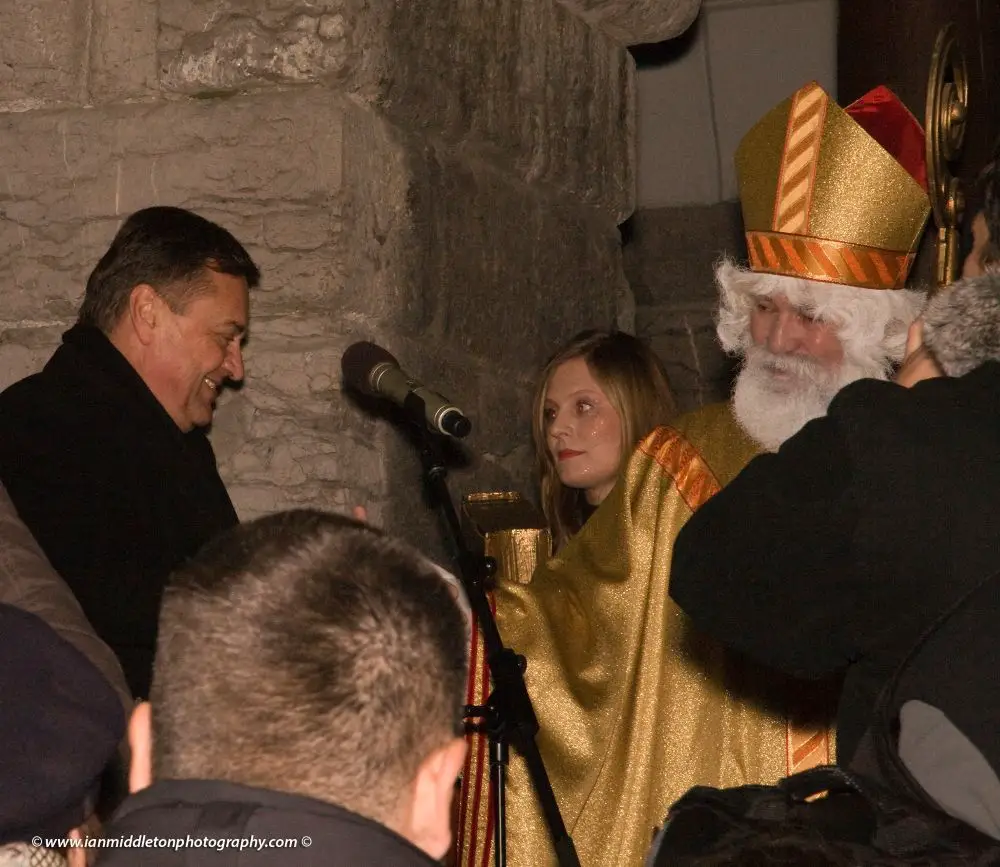
The Mayor of Ljubljana with Miklavs in Ljubljana centre. Photo: © Ian Middleton
Every year, on December 5th at 5.00pm, Ljubljana plays host to the Saint Nicholas procession, which marks the first of the three traditions of Christmas in Slovenia. Saint Nicholas is the universal name for Nicholas of Myra, a Christian Saint of the ancient town of Myra; a region in modern day Antalya in Turkey. He was born in AD270 and died 6thDecember, AD343. The Saint was renowned for his generosity. Legend says that he put coins into the shoes of people who left them in front of their house. He was especially revered for saving three girls from prostitution by providing them with dowries so they were eligible for marriage.
Related: Where and when to find Miklavž in Slovenia (2018 edition)
Even though he is a famous figure all across the Christian world, his image has been especially entrenched into Slovenian culture. Known here as Miklavž, tradition says that he comes from heaven on the eve of his death, 5th Dec, and bestows gifts of sweets, fruit and biscuits upon the children. He is accompanied by a flock of angels, who assist him to disperse the gifts to all the children who have been good that year. He is closely followed by parklji ‘the trotters’, the personifications of the devil who come and scare the bad children. The angels are also there to protect the bad children from the devil and warn them to be good in future years. The procession begins in front of the town hall in Mestni Trg, and continues on to Prešeren square where he addresses the crowd before disappearing into the Franciscan Church. Miklavž is depicted as having a long white beard and wears a long white Christian robe and a bishop’s hat.
The tradition of Miklavž isn’t limited to this procession, however. In the homes across Slovenia children put a shoe or stocking inside or outside their bedroom on Dec 5th and awake the next morning, in essence Saint Nicholas’ Day, to find it filled with food; typically the carob bean, mandarins, dry fruits such as dates, chocolates and other small snacks. The belief doesn’t promote lavish spending, but rather small, humble gifts totalling no more than a few euros.
Santa Claus in Slovenia
It’s actually from the story of Saint Nicholas that the modern day Santa Claus comes. His story was blended with the beliefs of other countries, and also pagan gods, to create the variations we see today around the world. The British created Father Christmas, who was blended with the Dutch Sinterklaas by the British and Dutch colonists in America to create the American Santa Claus. Various stories and publications further personified the image of Santa and the commercial image we see today was proliferated by a Coca Cola advert in 1930 in the USA. This image of Santa spread around the world and like most countries Slovenia embraced this belief, calling their Santa, Božiček. The Christian Saint Nicholas and the commercial Santa were discouraged during the Socialist era under Yugoslavia, but were revived shortly before independence. Slovenian children now get to experience the more modern commercial Christmas where the gifts are brought on the eve of the birth of Christ. But one difference here is that many families have their Christmas dinner on Christmas Eve, before going to holy mass. While the main meal is much the same as elsewhere, a unique desert served after dinner is a nut roll called Potica.
The Christmas customs here remain much the same as around the world; families decorate their homes and trees and children in schools compete to make Christmas Cribs, small boxes with dolls depicting the nativity. The most famous and elaborate depiction of the nativity is found in Postojna Caves. Over the Christmas week the banks of the Ljubljanica come alive with open-air bars selling hot food and drinks, including mulled wine to keep you warm on the freezing cold nights. The centre is lavishly decorated with a myriad of coloured lights, all of which are ceremoniously switched on at a big event on 3rd December at 5.00pm to not only mark the beginning of the Christmas period, but also to coincide with the birthday of France Prešeren.
Grandfather Frost (Dedek Mraz) in Slovenia
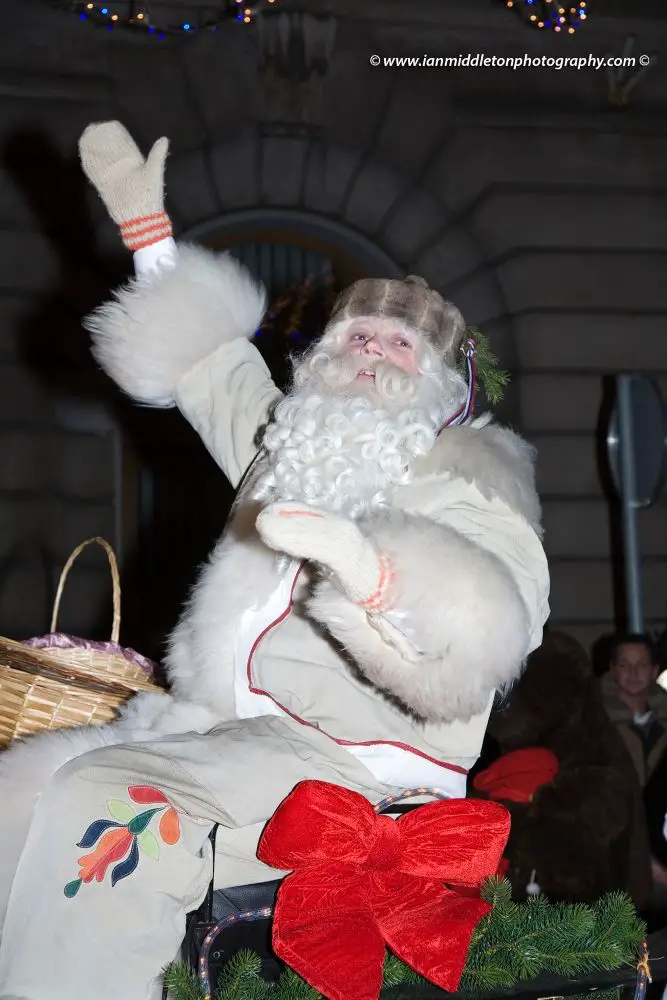
Dedek Mraz procession in Ljubljana, Slovenia. Photo: © Ian Middleton
December 31st sees the arrival of the third of Slovenia’s gift-bearers. Prior to 1991 the commercial Santa was not popular here. Historically, Saint Nicholas was commemorated. During the years under Yugoslavia though, all religious and commercial celebrations were frowned upon, but rather than ban them completely and be made to seem like the killjoy, the authorities replaced them with the Russian communist Ded Moroz, which was translated into Slovenian as Dedek Mraz, literally Grandfather Frost, but sometimes referred to as Grandfather Cold.
Dedek Mraz originated from the pagan culture of the Eastern Slavs, but became entrenched into Russian communist society as an alternative to western beliefs. Unlike Santa, Grandfather Frost doesn’t sneak presents to the children during the night, but hands them out personally at gatherings on New Year’s Eve. During the Socialist years companies would arrange a special event in a hall. The workers would bring their children and they would meet Dedek Mraz and be given a gift. But this gift-bearer is in stark contrast to the jolly fat Santa, being slim and wearing a long white coat and brown furry Russian kučma hat.
The break-up of Yugoslavia saw the open return of Miklavž and Santa, but Grandfather Frost was not tossed out with the rest of the Former Yugoslavia’s ways, but integrated into the new ways, thus providing Slovenian children with the providence of three days over Christmas where they receive presents. Dedek Mraz is believed to have his home under Triglav and emerges close to New Year’s Eve to visit children all across Slovenia.
From Dec 26th to 30th Dedek Mraz will ride through Ljubljana on his carriage pulled by two Lipizzaner horses and appear in Krekov trg, Ciril-Metodov trg, Stritarjeva ulica, Prešernov trg, Wolfova ulica and Zvezda Park.
Today many families follow the tradition of all three, and rather than being the enemies of the old ways they have been harmonized and each has retained his place in Slovenian Christmas tradition.
The week of celebrations along the Ljubljanica culminate in a climatic display of fireworks launched from the castle overlooking the old town and city centre. Crowds gather in Prešeren Square and along the river to view this spectacle and see in the New Year with wine, champagne and music.
Related: Turning on the Christmas Lights in Slovenia - when and where to see them
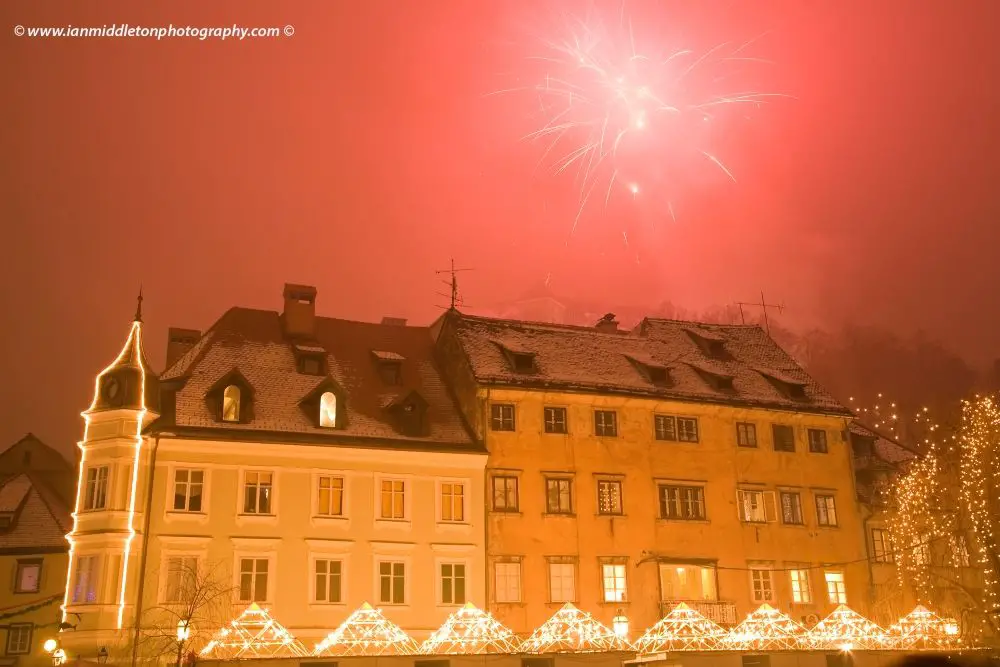
Fireworks from the Castle above the Old Town in Ljubljana, Slovenia for New Year’s Eve 2007/2008. Unfortunately fog obscured the Castle. Photo: © Ian Middleton
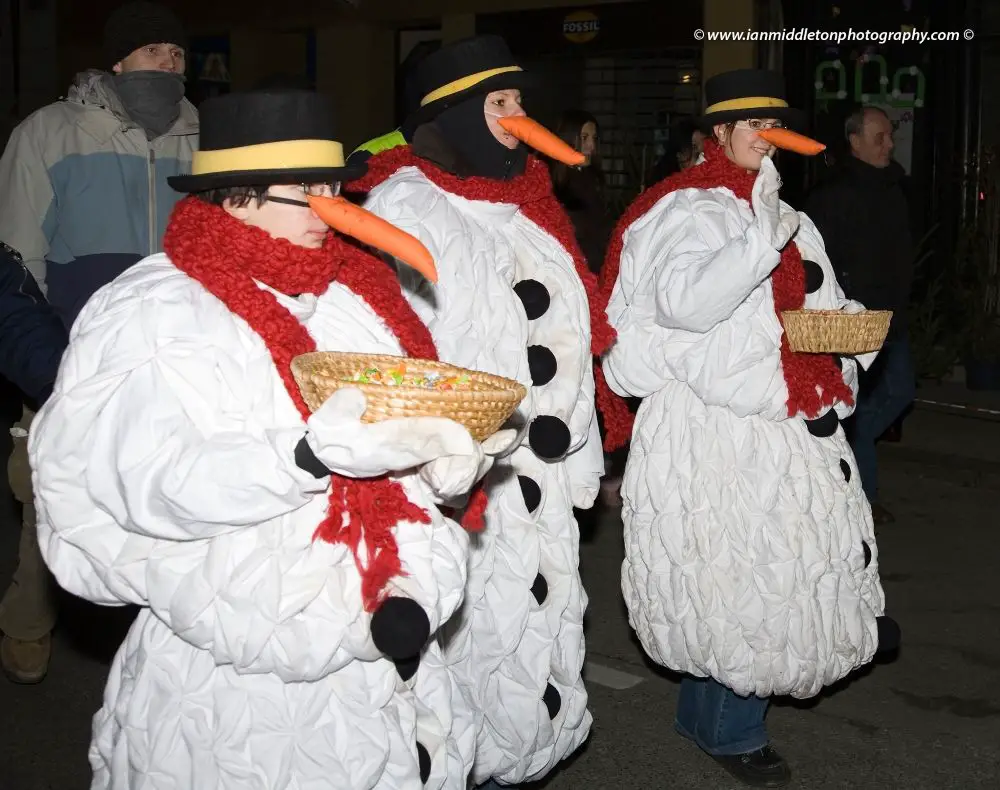
Dedek Mraz procession in Ljubljana. Photo: © Ian Middleton
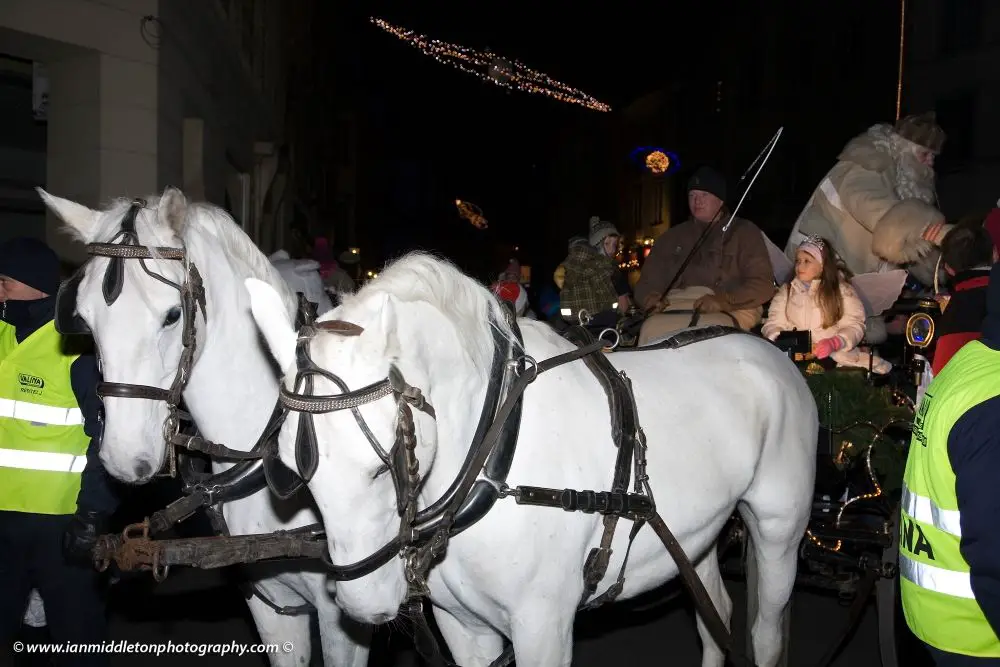
Dedek Mraz procession in Ljubljana. Photo: © Ian Middleton
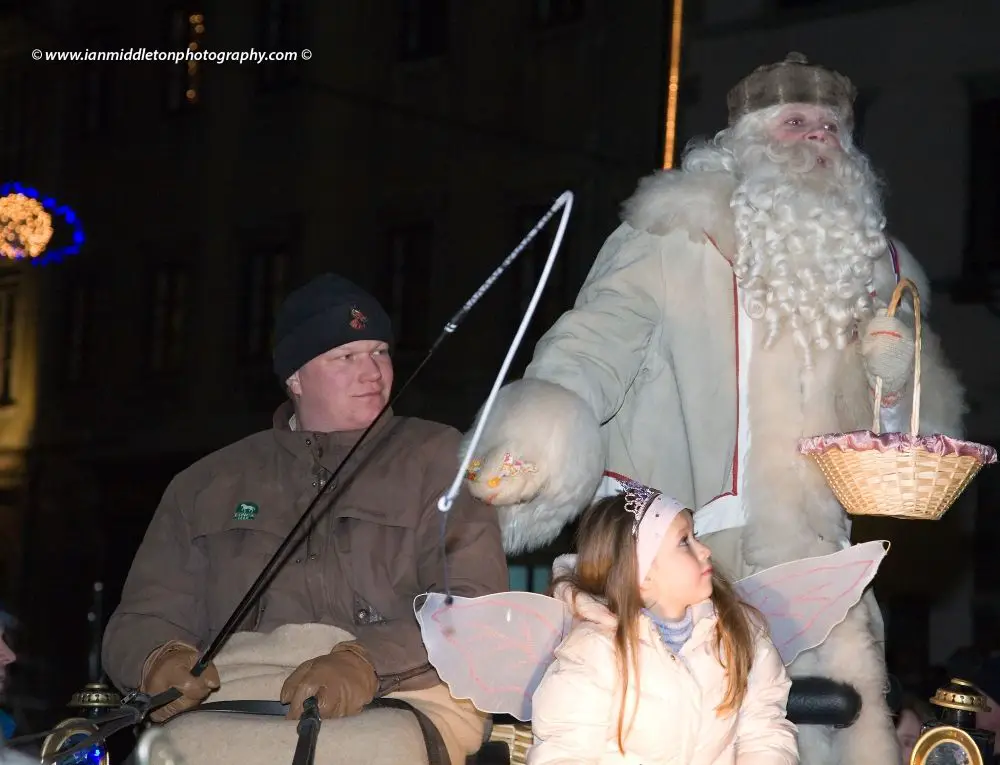
Also known as Grandfather Cold or Grandfather Frost, this tradition was used by the communists as a replacement for the western Santa Claus. The tradition comes from an ancient Russian Legend of Ded Moroz, and he wears a white outfit and Russian Kuchma Hat. Photo: © Ian Middleton
You can enjoy more of Ian's travel writing and photography elsewhere on Total Slovenia News, or on his website.
STA, 20 November 2018 - Small and medium-sized enterprises in Slovenia generate 65.1% of added value and 73.4% of jobs in the non-financial sector of the economy, which is above the EU average, according to the annual report from the European Commission. The annual productivity of these companies was however almost 25% below the EU average.
According to the 2017/2018 annual report on European SMEs, Slovenian SMEs in the non-financials sector recorded a steep growth between 2013 and 2017.
Their added value was up by 33.4%, and number of employees by 5.6%, which is well above the performance of large companies in this department.
In the 2016-2017 period, added value generated by SMEs was up by 8.8%, which was the largest annual increase since 2008. Employment in the same period was up by 2.9%, which is also the largest increase since 2008.
Forecast remains positive for SMEs
The outlook for SMEs and the non-financial sector in Slovenia as a whole remains positive. Added value generated by SMEs is expected to increase by 11.6% in the 2017-2019 period, and employment by 0.6%.
According to the European Commission, the main challenge for Slovenia is still the shortage of qualified staff. It sees a solution in closer ties between the economy and the education system.
The Commission also thinks that Slovenia should find alternative sources of financing, especially for fast-growing companies which deal with innovation. It also calls for further reduction of administrative barriers.
The report, published on Tuesday, coincides with the 2018 SME Assembly, which is taking place in Austria's Graz between Monday and Wednesday. The European Enterprise Promotion Awards will be conferred there this evening.
STA, 20 November - While Hungarian Prime Minister Viktor Orbán announced last week that the country was withdrawing from the investment in the Koper-Divača rail project, Foreign Minister Péter Szijjártó said on Tuesday as he paid a visit to Slovenia that the option remained open, Radio Slovenija reported.
According to the national radio, Slovenian Foreign Minister Miro Cerar has obviously convinced his Hungarian counterpart that the Slovenian government is yet to decide on the neighbour's participation in the project.
Szijjártó, who is visiting Slovenia upon an invitation from Cerar, told Radio Slovenija that the Slovenian government had not yet decided on Hungary's participation in the construction of a new rail line between the port of Koper and the Divača inland hub.
"My good friend Miro Cerar informed me that we should not understood the statements by your infrastructure ministry as the decision of the Slovenian government," the Hungarian foreign minister said.
Infrastructure Minister Alenka Bratušek said on Monday that Hungary was interested in the project to get a piece of the Slovenian coast and that that would never happen.
"If this is the reason that [Hungary] will not be involved, then be it," she added and reiterated that Slovenia was able to build the rail on its own.
Szijjártó today labelled Bratušek's statements as discouraging. "We had achieved great progress in the time when Cerar was your prime minister," he told Radio Slovenija.
According to hum, Hungary is also looking for opportunities in other ports. In Koper, the landlocked eastern neighbour transships two million tonnes of cargo, which is 10% of total transshipment in the port.
Szijjártó is in Ljubljana today for the opening of the 34th Slovenian Book Fair, where Hungary is the guest country.
Szijjártó and Cerar had a working meeting at Strmol Castle to confirm the excellent bilateral relations and regular dialogue between the countries, following the official visit at the end of October by Hungarian President Janos Ader.
What connects the countries is the protection of ethnic minorities from both sides of the border, the Foreign Ministry said in a press release.
Szijjártó and Cerar also discussed economic cooperation, investment opportunities, cross-border infrastructural projects, including power lines and gas pipeline connections between the countries, and topical EU and international issues.
All of our stories related to Hungary can be found here
Below is a review of today’s news in Slovenia, summarised by the headlines in the daily newspapers for Wednesday, 21 November 2018, as prepared by the STA:
DELO
Swiss franc loans
"Cold shower for Swiss franc borrowers": Banks seem to have achieved a milestone victory in the battle against Swiss franc borrowers. The Supreme Court has rejected a revision demanded by the borrowers, ruling that the borrowers were acquainted with the risks associated with the loan. (front page, 11)
Intelligence
"Operator A1 did not enable taping": Slovenia's second biggest mobile operator, the Austrian-owned A1 which provides its services to the country's top politicians and the entire public administration, is causing problems to the SOVA intelligence agency by not allowing tapping. (front page, 3)
Koper-Divača rail project
"New breaks for second track": The Koper-Divača rail track has again heated up the political atmosphere, this time within the coalition. Former PM Miro Cerar, now foreign minister, is bothered by any moves by the new infrastructure minister, Alenka Bratušek. (front page, 2)
DNEVNIK
Education
"Information must be available to individuals": The Constitutional Court has been asked to deliberate on whether ranking primary schools and secondary schools based on the performance of their students in national exams is in line with the Constitution. (front page, 2)
Housing in Ljubljana
"Novo Brdo neighbourhood: Construction postponed due to audit": The construction of 498 apartments in the Novo Brdo neighbourhood has been postponed because the company Strabag filed for auditing the project. (front page, 9)
Weather
"Slovenia: First round of snow this winter": Most parts of Slovenia were covered in snow yesterday. The snow also caused some problems on the roads, but no precipitation is expected in the coming days. (front page)
FINANCE
Crypto currencies
"A year after euphoria: New dip on crypto markets": The paper looks at the causes for the plummet of cryptocurrencies, especially the most popular one, bitcoin. (front page, 6-7)
Public spending
"Šarec wants to give out millions, but he does not know yet where to get them": The supplementary budget for 2019 will be the first serious test for this government, which is promising higher public sector pay, more funds for municipalities, holiday allowance for pensioners and unchanged social transfers. (front page, 2-3)
NLB shares
"Who made the most money off NLB shares in the first week of trading?": So far, everyone who has already sold NLB shares has made money off them, because their value on the stock market is higher than their price in the IPO, the paper says. (front page, 10-11)
VEČER
Anniversaries related to Rudolf Maister
"Peaks of Maister's year": A number of events will be held around the country these days to mark Rudolf Maister Day and other important anniversaries related to the WWI general credited with protecting part of what is today's border with Austria. (front page, 16)
Koper-Divača rail project
"'Stalling' the second track": The paper wonders whether the recent developments related to the Koper-Divača rail project are all about Hungary's selfish interests or is it a political battle. (front page, 2-3)
Nataša Vodušek case
"Dismissal of Vodušek legal": The Supreme Court has ruled that the dismissal of former Ambassador Nataša Vodušek was in line with the law. (front page, 21)
STA, 20 November 2018 - Slovenia will get significantly hotter by the end of the century as greenhouse gas emissions drive climate change, and even the most optimistic scenarios show that the frequency and severity of heat waves will increase. Precipitation patterns will be upended as well, in particular in winter, the latest climate projections show.
The projections, released by the Slovenian Environment Agency on Tuesday, consider three scenarios of climate change compared to the reference years 1981-2010 - and under all of them the changes will be profound.
Average temperatures set to rise
Average temperatures, having already increased by 2.2 degrees Celsius since pre-industrial times by 2011, are projected to rise by 1.3 degrees by the end of the century according to the most optimistic scenario and as much as 6 degrees according to the most pessimistic scenario.
The number of hot days will increase by 6-27 days depending on scenario, but even under the most optimistic scenario heat waves will be much more common and longer.
There will be at least one heat wave each year as bad or worse than the record-setting heat wave of 2003. "By the end of the century, 2003 could be considered quite fresh," Environment Agency researcher Gregor Vertačnik said.
The flip side of the warmer climate will be a significantly longer growing season, which could begin a month earlier and end a month later, without an increase in the probability of spring frost.
More rain is expected under both optimistic and pessimistic projections
In the past fifty years Slovenia has been getting drier, with precipitation dropping by about a tenth and the snow cover by more than half.
But by the end of the century, the situation is likely to be completely different, especially in eastern Slovenia.
In the moderately optimistic and pessimistic scenarios precipitation is expected to increase by 20% by the end of the century, but the overall increase masks even more profound seasonal changes.
In the pessimistic scenario, winter precipitation is projected to increase by 40% by the middle of the century and up to 60% by the end of the century.
In other seasons the change will not be so profound, though projections show a significant increase in extreme weather events such as flooding in general.
Droughts not a problem
The good news, according to the agency, is that Slovenia will not have a shortage of water, as the average annual replenishing of aquifers will increase by about a fifth.
But this also means waterways are more likely to spill over.
The Environment Agency said the projections show climate change will impact every facet of life and required adaptation.
"The projections are primarily a groundwork for adaptation to climate change. But they can also be used in strategic projects with a long time span which must be resilient to climate change. Everyone planning such projects needs our forecasts," according to the agency's chief climatologist Mojca Dolinar.
Barbara Simonič of the Ministry of the Environment and Spatial Planning said resilience to climate change needed to improve. She said the national-level projections must now be followed-up by assessments for individual sectors.
While the analysis considers three scenarios, the agency also warns that there is a high degree of uncertainty, with the gravity of change depending on how much humanity manages to limit greenhouse gas emissions and how reliable the forecasting models are.
Our other stories on climate change sand Slovenia are here





